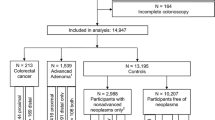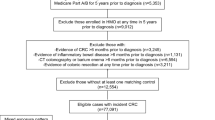Abstract
Asymptomatic men (N=114) 50 years of age or older had screening for colorectal neoplasia with flexible sigmoidoscopy followed by colonoscopy regardless of the sigmoidoscopic result. Our study objective was to determine the prevalence of patients having isolated adenomatous polyps in a proximal colonic segment in the absence of a distal index neoplasm within reach of the sigmoidoscope. Through the combined use of sigmoidoscopy and colonoscopy, adenomatous polyps were detected in 47 of 114 individuals (41%). A total of 88 adenomas was found. Seventeen patients had isolated neoplasms in proximal colonic segments in the absence of distal adenomas. These patients represented 15% of screened subjects (17 of 114) and 20% of individuals who lacked adenomas on sigmoidoscopy (17 of 84). The majority of proximal neoplasms were small (<1.0 cm), tubular adenomas. Flexible sigmoidoscopy may be ineffective for screening asymptomatic men for neoplasia. However, it remains to be determined if a 20% miss rate (for those with a normal sigmoidoscopic examination) is significant and whether small proximal adenomas are worth finding.
Similar content being viewed by others
References
Sherlock P, Winawer SJ: Are there markers for the risk of colorectal cancer? N Engl J Med 311:118–119, 1984
American Cancer Society: Cancer of the colon and rectum. Ca 30:208–215, 1980
Lambert R, Sobin LH, Waye JD, et al: The management of patients with colorectal adenomas. Ca 34:167–176, 1984
Fleischer DE, Goldberg SB, Browning TH, et al: Detection and surveillance of colorectal cancer. JAMA 261:580–585, 1989
Blatt LJ: Polyps of the colon and rectum: Incidence and distribution. Dis Colon Rectum 4:277–282, 1961
Arminski TC, McLean DW: Incidence and distribution of adenomatous polyps of the colon and rectum based on 1000 autopsy examinations. Dis Colon Rectum 7:249–261, 1964
Eide TJ, Stalsberg H: Polyps of the large intestine in northern Norway. Cancer 42:2829–2848, 1978
Rickert RR, Auerbach O, Garfinkel L, Hammond EC, Frasca JM: Adenomatous lesions of the large bowel: An autopsy survey. Cancer 43:1847–1851, 1979
Williams AR, Balasooriya BAW, Day DW: Polyps and cancer of the large bowel: A necropsy study in Liverpool. Gut 23:835–842, 1982
MaCrae FA, St John DJ: Relationship between patterns of bleeding and Hemoccult sensitivity in patients with colorectal cancers or adenomas. Gastroenterology 82:891–898, 1982
Letsou G, Ballantyne GH, Zdon MJ, Zucker KA, Modlin IM: Screening for colorectal neoplasms: A comparison of the fecal occult blood test and endoscopic examination. Dis Colon Rectum 30:839–843, 1987
Foutch PG, Manne RK, Sanowski RA, Gaines JA: Risk factors for blood loss from adenomatous polyps of the large bowel: A colonoscopic evaluation with histopathological correlation. J Clin Gastroenterol 10:50–56, 1988
Knight KK, Fielding JE, Battista RN: Occult blood screening for colorectal cancer. JAMA 261:587–593, 1989
World Health Organization: Histological typing of intestinal tumors.In International Histological Classification of Tumors, Vol 15. BC Morson, LH Sobin, (eds.):, Geneva, WHO, 1976
Correa P, Strong JP, Reif A, Johnson WD: The epidemiology of colorectal polyps: Prevalence in New Orleans and international comparisons. Cancer 39:2258–2264, 1977
Vatn MN, Stalsberg H: The prevalence of polyps of the large intestine in Oslo: An autopsy study. Cancer 49:819–825, 1982
Burt RW, Samowitz WS: The adenomatous polyp and the hereditary polyposis syndromes. Gastroenterol Clin North Am 17:657–678, 1988
Canadian Task Force on the Periodic Health Examination: The periodic health examination: 2. 1989 Update. Can Med Assoc J 141:209–216, 1989
Neugut AI, Pita S: Role of sigmoidoscopy in screening for colorectal cancer: A critical review. Gastroenterology 95:492–499, 1988
Ujszaszy L, Pronay G, Nagy G, et al: Screening for colorectal cancer in a Hungarian county. Endoscopy 17:109–112, 1985
Yarborough GW, Waisbren BA: The benefits of systematic fiberoptic flexible sigmoidoscopy. Arch Intern Med 145:95–96, 1985
Frame PS: Screening flexible sigmoidoscopy: Is it worth-while? An opposing view. J Fam Pract 25:604–607, 1987
Selby JV, Friedman GD: Sigmoidoscopy in the periodic health examination of asymptomatic adults. JAMA 261:595–601 1989
Konishi F, Morson BC: Pathology of colorectal adenomas: A colonoscopic survey. J Clin Pathol 35:830–841, 1982
Warden MJ, Petrelli NJ, Herrera L, Mittelman A: The role of colonoscopy and flexible sigmoidoscopy in screening for colorectal carcinoma. Dis Colon Rectum 30:52–54, 1986
Achkar E, Carey W: Small polyps found during fiberoptic sigmoidoscopy in asymptomatic patients. Ann Intern Med 109:880–883, 1988
Health and Public Safety Committee, American College of Physicians: Clinical competence in colonoscopy. Ann Intern Med 107:772–774, 1987
Foutch PG, Mai HD, Pardy K, et al: The index hyperplastic polyp is a reliable marker for synchronous neoplasia in the proximal colon. Gastrointest Endosc 36:212, 1990 (abstract)
Muto T, Bussey HJR, Morson BC: The evolution of cancer of the colon and rectum. Cancer 36:2251–2270, 1975
Winawer SJ, Sherlock P: Surveillance for colorectal cancer in average-risk patients, familial high-risk groups and patients with adenomas. Cancer 50:2609–2614, 1982
O'Brien MJ, Winawer SJ, Zauber AG, et al: The National Polyp Study: Patient and polyp characteristics associated with high grade dysplasia in colorectal adenomas. Gastroenterology 98:371–379, 1990
DiSario JA, Foutch PG, Manne RK: Colorectal adenomas: Factors associated with higher grades of dysplasia in asymptomatic, average risk men. Am J Gastroenterol 85:1275, 1990 (abstract)
Rex D, Lehman G, Hawes R, Ulbright TM, Smith JJ: Screening colonoscopy in asymptomatic average risk persons with negative fecal occult blood tests. Gastroenterology 100:64–67, 1991
Lieberman D, Smith F: Screening asymptomatic subjects for colon malignancy with colonoscopy. Gastroenterology 98:A294, 1990
Author information
Authors and Affiliations
Rights and permissions
About this article
Cite this article
Foutch, P.G., Mai, H., Pardy, K. et al. Flexible sigmoidoscopy may be ineffective for secondary prevention of colorectal cancer in asymptomatic, average-risk men. Digest Dis Sci 36, 924–928 (1991). https://doi.org/10.1007/BF01297142
Received:
Revised:
Accepted:
Issue Date:
DOI: https://doi.org/10.1007/BF01297142




